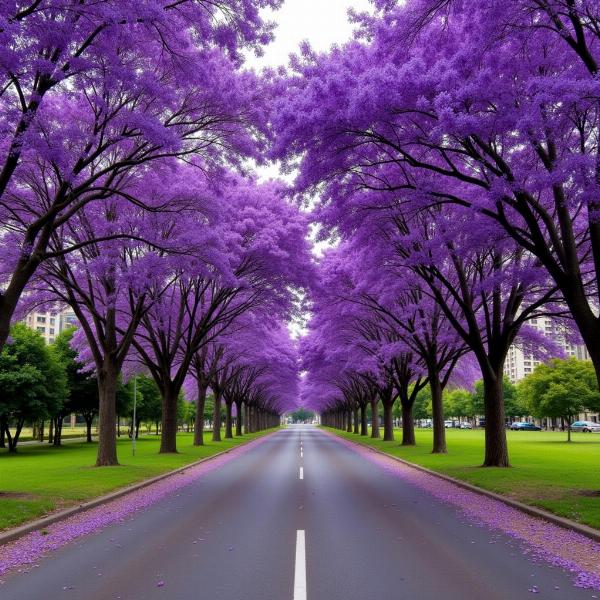Jacaranda, with its vibrant purple blossoms, is a sight to behold. But what does “jacaranda” mean in Hindi? While there isn’t a direct single-word translation for “jacaranda” in Hindi, it’s often referred to as नीलमोहर (neelmohar), meaning “blue peacock flower,” or sometimes जकरंदा (jakaranda), a transliteration of the English word. This beautiful tree, though not native to India, has become a cherished part of its landscape and cultural imagery.
Understanding the Neelmohar: Jacaranda in India
The jacaranda tree, scientifically known as Jacaranda mimosifolia, is native to South America but thrives in India’s tropical climate. Its vibrant purple flowers, resembling bunches of grapes, bloom profusely during the spring, transforming avenues and gardens into breathtaking displays of color. The neelmohar’s beauty has captured the imagination of poets and artists, becoming a symbol of spring, renewal, and the ephemeral nature of beauty.
Why is Jacaranda called Neelmohar in Hindi?
The name neelmohar perfectly encapsulates the tree’s appearance. Neel means blue, and mohar refers to the peacock flower, a common name for the Delonix regia tree, which also boasts vibrant blossoms. The jacaranda’s purple flowers, with their bluish tinge, coupled with their resemblance to the peacock flower’s shape, led to this apt moniker. The name also reflects the cultural significance of the peacock in India, further enhancing the neelmohar’s appeal.
Cultural Significance of Jacaranda in India
Though an introduced species, the jacaranda has woven itself into the fabric of Indian life. Its blooming season coincides with exam time for many students, making it a symbol of both stress and hope. The falling flowers are often seen as a metaphor for fleeting time and the beauty of impermanence. The neelmohar is a popular subject in Indian art, literature, and music, often romanticized as a symbol of love, longing, and nostalgia.
Different Names for Jacaranda in India
While neelmohar is the most common name, regional variations exist. In some parts of India, it’s also called neeli gulmohar, further emphasizing its blue hue. The transliteration jakaranda is also gaining popularity, especially among younger generations. This linguistic diversity reflects India’s rich cultural tapestry and the varied ways in which the jacaranda has been embraced.
Jacaranda in Literature and Art
Indian poets and writers often use the neelmohar to evoke a sense of romanticism and longing. Its vibrant color and fleeting bloom serve as metaphors for the transient nature of life and love. Painters and photographers are also drawn to its beauty, capturing its vibrant hues in various art forms.
 A street lined with jacaranda trees
A street lined with jacaranda trees
Conclusion
The jacaranda, known as neelmohar in Hindi, has become a beloved tree in India, symbolizing spring, beauty, and the passage of time. Its vibrant purple flowers and cultural significance have cemented its place in Indian hearts and landscapes. Whether you call it neelmohar, jakaranda, or simply appreciate its beauty, this tree is a testament to nature’s artistry. So, next time you see a jacaranda in bloom, remember its various names and the rich cultural context it holds in India.
FAQs
- What is the scientific name of jacaranda? Jacaranda mimosifolia
- When do jacaranda trees bloom in India? Typically during the spring season.
- Is jacaranda native to India? No, it’s native to South America.
- What are the other names for jacaranda in India? Neelmohar, neeli gulmohar, and jakaranda.
- Why is jacaranda called neelmohar? Because of its blue-tinged purple flowers resembling the peacock flower (mohar).
- What does jacaranda symbolize in India? Spring, renewal, fleeting beauty, and sometimes, exam season.
- Is jacaranda mentioned in Indian literature and art? Yes, it’s a popular subject, often used to evoke romanticism and nostalgia.
Meaning-Hindi.in is your one-stop solution for all your Hindi translation needs. We offer a comprehensive range of services, including business and commercial document translation, certified and legal document translation, technical and user manual translation, website and localization services, educational and academic document translation, express translation, and specialized industry translation. Contact us at [email protected] or +91 11-4502-7584 to learn more about our services. Let Meaning-Hindi.in help you bridge the language gap and achieve your communication goals!